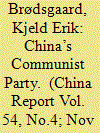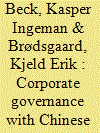|
|
|
Sort Order |
|
|
|
Items / Page
|
|
|
|
|
|
|
| Srl | Item |
| 1 |
ID:
162353


|
|
|
|
|
| Summary/Abstract |
The Communist Party of China (CPC) is not withering away as predicted by some Western scholars. On the contrary, in recent years, the party has centralised and strengthened its rule over China. At the same time, party membership has changed. Today, workers and farmers only account for only one-third of the total party membership compared to two-thirds when the People’s Republic of China (PRC) was established. Instead, new strata and groups such as technical and management personnel have evolved. The composition of the party’s cadre corps has changed accordingly, and cadres today are younger and much better educated than during Mao’s time. The leading cadres form an elite which is at the heart of a ranking-stratified political and social system. This article discusses how the CPC has evolved from a mass to an elite party. It argues that in this process, the party has taken over the state resulting in a merger and overlap of party and government positions and functions, thereby abandoning Deng Xiaoping’s ambidextrous policy goals of separating party and government. Centralisation and reassertion of ranking-stratified party rule is Xi Jinping’s answer to the huge challenges caused by the economic and social transformation of Chinese society—not a return to Mao’s mass party.
|
|
|
|
|
|
|
|
|
|
|
|
|
|
|
|
| 2 |
ID:
185621


|
|
|
|
|
| Summary/Abstract |
This article analyses the role of the Chinese Communist Party (CCP) in the corporate governance of Chinese state-owned enterprises (SOEs), including a case study of a central-level SOE holding group. Relying on official documents, secondary literature and interviews with enterprise managers, government officials and academics, the article documents how the CCP has actively formalized its role in Chinese business by embedding itself in the corporate governance structure of SOEs. Through the application of Chinese indigenous administrative corporate governance concepts such as “bidirectional entry, cross appointment” and “three majors, one big,” the CCP has consolidated its dominance of enterprise decision-making procedures and personnel appointment and created a hybrid, Party-led model of corporate governance. While this hybrid model can secure enterprise compliance, communication with higher state and Party organs, as well as long-term development planning, it is unlikely to help solve SOE efficiency problems and may even undermine other SOE reforms.
|
|
|
|
|
|
|
|
|
|
|
|
|
|
|
|
| 3 |
ID:
172270


|
|
|
|
|
| Summary/Abstract |
The SOE (state-owned enterprise) sector provides an important avenue to political power in China. A number of SOE executives are members of the Central Committee of the Communist Party of China (CPC) and often they change career tracks to become leading government and Party officials. In the past, the oil and gas sector was a significant recruitment basis for government and Party leaders. However, in recent years, the aerospace sector has become more dominant. This is a result of the anti-corruption campaign which has, in particular, targeted the oil sector, and also reflects the emergence of new sectors and social groups due to changing political and socio-economic conditions of Chinese society. The oil and gas industry is an old industry associated with China's heavy-industrial growth model of the past, whereas aerospace represents China's technological future.
|
|
|
|
|
|
|
|
|
|
|
|
|
|
|
|
|
|
|
|
|